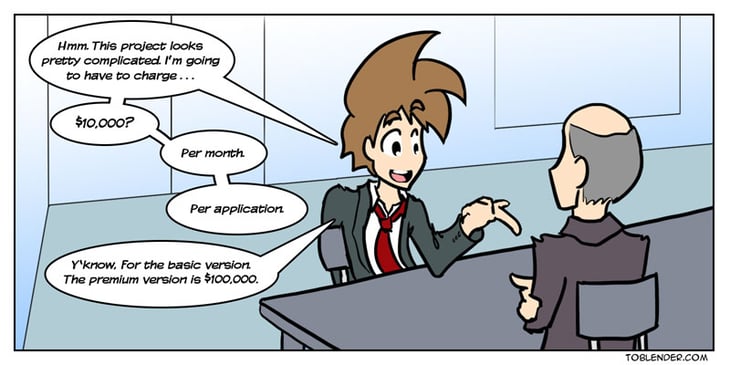Welcome to this week's TBT post!

If you have ever spent any time out at various pubs and bars you are bound to run across a sign hanging on the wall at one of these establishments that promises "Free drinks…tomorrow”. The joke being that it will never happen because tomorrow’s always a day away. Last week's discussions on the shortcomings of PLM pricing models in my blog titled "The Price is Right or is it?" and Oleg Shilovitsky's follow up "How to Disrupt PLM Price with Technologies?" generated a lot of response and discussion and made me start to think about what type of price model PLM vendors should consider to fully capitalize on the benefits their technology offer. Oleg writes about the influence of the free price market and what impact that could have on PLM vendors with high priced offerings and disenchanted users. Is it possible that a major PLM vendor would consider some sort of free offering to gain market share? Probably not. More likely, it would be a smaller company using a model like SugarCRM does in the CRM space where they offer some sort of free solution with less functionality as an entry point to capture customers for a more robust offering for a charge (Aras?). Product Lifecycle Management (PLM) needs wide adoption to fulfill its value proposition and as one reader pointed out it if it doesn't have the necessary functionality it doesn't matter how inexpensive it is. In this blog, we will explore some different approaches vendors could leverage beyond today's traditional per user pricing models that would allow PLM to propagate as needed yet still allow vendors to achieve their financial objectives. Given the payback properly implemented PLM provides, with the right approach, we could have our free PLM software today..
Just as a point of discussion, what would happen to the industry if one of the major players in PLM decided to offer their base client for free? I think it could have an interesting effect on PLM adoption and drive a lot of revenue for the company that does it. Oracle is a great example of a company that could benefit immensely from this approach and put a lot of pressure on their competition. I recently attended an Oracle Kickoff Meeting and while I am somewhat restricted about revealing specific numbers it is safe to say that Agile PLM has benefited significantly from Oracle's ownership. PLM revenues for Oracle grew significantly last year. That being said, PLM is just a small piece in the overall Oracle technology stack. Significant revenue was also generated from Siebel CRM, Hyperion and other business intelligence offerings, and obviously from Oracle's ERP solutions. Never mind the millions that are collected for Oracle database technologies used by Oracle's own solutions and practically everyone else in the PLM and ERP space. The point is that as successful as Agile PLM has been for Oracle the revenue derived from it in Oracle's overall numbers is very low. If you look further into the revenue numbers for Agile PLM, I suspect that a significant amount of the revenue is generated by modules other than the core Product Collaboration Module. What all this means is that it would be possible for Oracle to make the Product Collaboration Module free, which would significantly expand their PLM footprint, which would most likely lead to adoption of additional modules of Agile and potentially lead to sales of other Oracle products. The net effect of this could easily allow Oracle to eclipse the revenue numbers of this last year, put immense pressure on their competitors, and put them in a dominant position in product development technology solutions. If you own the data, you pretty much own the technology stack. Other companies would have difficulty following Oracle down this path since they don't have the breadth and more importantly probably must pay Oracle for the database licenses they use which Oracle requires be licensed per user in most cases. I don't think this will ever happen but imagine the fun if it did.
So, given the fact that it is unlikely that major PLM vendors are going to start giving away their software, how else can a company get free PLM software? The only way this works is thru value-based selling and pricing. Another announcement at the Oracle meeting I found interesting was from Ted Stuart, Vice President of the Central Region for Oracle's Midsize Business. He stated that Oracle was transitioning from being a "solutions"-based sales organization to a "value"-based sales organization. Since the transition began, Oracle has gathered metrics on the impact of this shift and has determined that transaction sizes doubled because of the new approach. Does this mean Oracle is charging more or clients are buying more? I suspect a little of both. By shifting the focus away from the solution and toward the value that the solution provides, companies become less concerned about cost. This effect makes discussions about pricing models somewhat irrelevant. If PLM vendors can convince their client base that the result of purchasing PLM software is a net gain for the company, then what difference does it make how much the software cost? Obviously, when any purchase is made, the expectation is that there will be some return on investment; but, as we discussed in previous blogs, it is very difficult to quantify the value of some of PLM 's benefits. However, if PLM vendors become more oriented to the issues that companies are encountering in their product development process and solve these issues with technology, then it shifts the discussion and allows PLM vendors to shift to more value-based pricing structures as opposed to having to quibble over cost per seat. This isn't that revolutionary per se since most PLM vendors and service partners for that matter aspire to get to this place with their clients. It comes down to execution. If PLM vendors can successfully identify and target business issues of their clients and quantify the impact they are having on these issues, then the pricing discussion falls by the wayside.

Let's assume that these value-based initiatives don't achieve their full potential, and there are still companies constrained by current pricing structures, and that with the advent of social product development (outsourcing, design for cost, etc.), more and more resources are going to need to gain access to the data created in PLM systems. How can PLM vendors successfully meet the need of the casual user without diluting their price point? Many vendors today distinguish between types of users. PTC has light and heavy users and SOLIDWORKS has creators and collaborators. Both offer a lesser price for the "consumer" license. Arena even offers "supplier" license which are even less expensive. If you look at other industries and other technologies, most vendors have moved away from charging people to look at the results of authoring. Word processing has PDF's and the Adobe free viewer, Computer Aided Design (CAD) has several standards including PDF, STEP and IGES, and there are a number of free viewers that people can use to view this output. There is a PLM standard originated from Agile called PDX that allows viewers to see Bill of Material (BOM), attributes, and attachments but it is not an industry-wide standard. I think everyone would benefit if PLM vendors drastically reduced or even eliminated the cost of viewer type licenses. If they don't, most companies will figure out a way to extract data from the PLM and view it outside the system which diminishes PLM value. I also think concurrent use models are a reasonable way to address the ever-changing needs of a company as far as users are concerned. Depending upon the project and resources needed to fulfill, the users for PLM can shift significantly. With the advent of Web clients and the improvement in the interface, casual users become more likely, which means you need a license structure that can accommodate short term usage, other than drastically reducing or eliminating the cost of viewer license; for PLM, floating licenses seem the only fair way to go.
Whether PLM software vendors give away software or focus on value or offer viewer licenses for less money, the bottom line is that the market will ultimately dictate the solution. With technologies like social media driving more and more communication, PLM solutions are adapting to leverage this new trend. Ultimately this will increase the number of users of the technology and pricing models need to reflect this new trend. Current pricing structures are based on traditional usage patterns. With increased volume should come price relief or new structure. Free PLM software may always be a day away but PLM vendors need to recognize the new landscape and more effectively communicate value and adjust their models to reflect how companies use their technology.
[Edit: repost from 2010]



